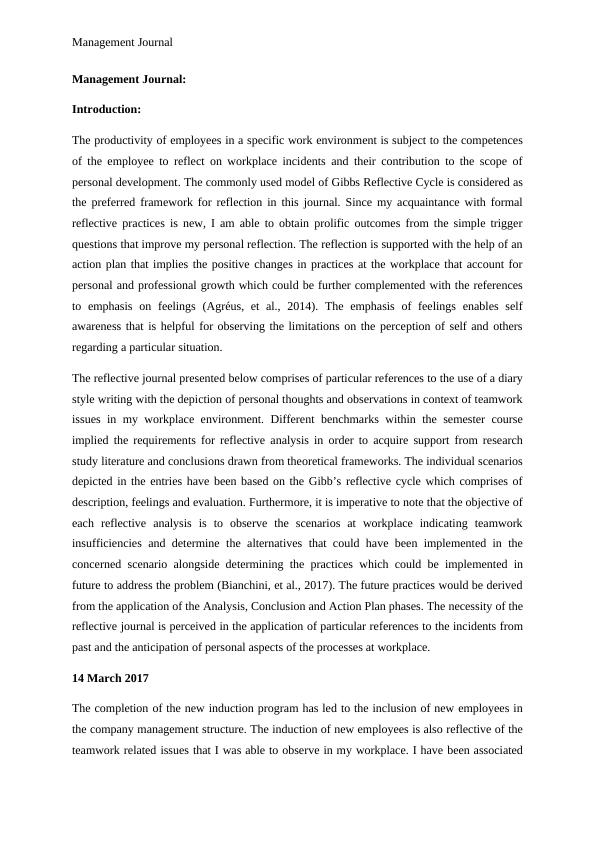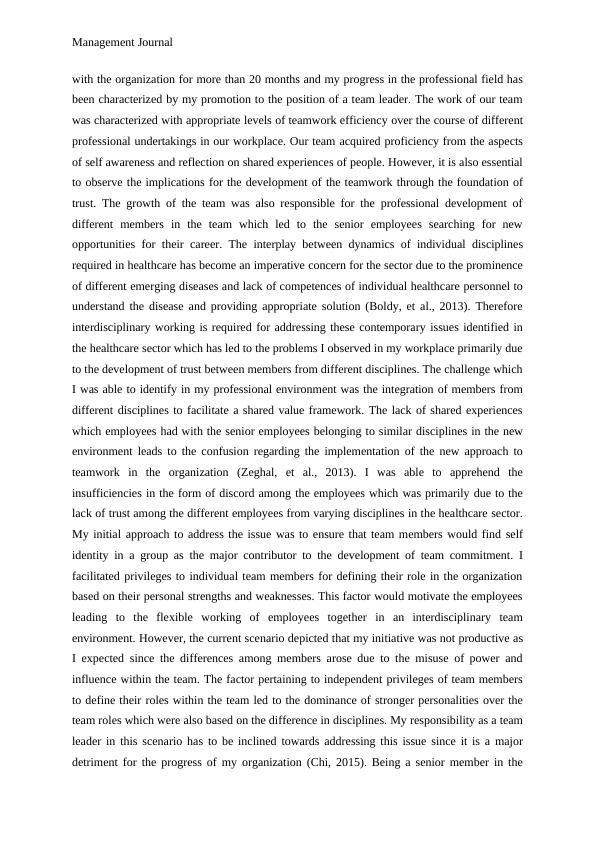Introduction to the Management Journal
11 Pages4620 Words39 Views
Added on 2020-04-01
Introduction to the Management Journal
Added on 2020-04-01
ShareRelated Documents
Management JournalManagement Journal:Introduction:The productivity of employees in a specific work environment is subject to the competencesof the employee to reflect on workplace incidents and their contribution to the scope ofpersonal development. The commonly used model of Gibbs Reflective Cycle is considered asthe preferred framework for reflection in this journal. Since my acquaintance with formalreflective practices is new, I am able to obtain prolific outcomes from the simple triggerquestions that improve my personal reflection. The reflection is supported with the help of anaction plan that implies the positive changes in practices at the workplace that account forpersonal and professional growth which could be further complemented with the referencesto emphasis on feelings (Agréus, et al., 2014). The emphasis of feelings enables selfawareness that is helpful for observing the limitations on the perception of self and othersregarding a particular situation. The reflective journal presented below comprises of particular references to the use of a diarystyle writing with the depiction of personal thoughts and observations in context of teamworkissues in my workplace environment. Different benchmarks within the semester courseimplied the requirements for reflective analysis in order to acquire support from researchstudy literature and conclusions drawn from theoretical frameworks. The individual scenariosdepicted in the entries have been based on the Gibb’s reflective cycle which comprises ofdescription, feelings and evaluation. Furthermore, it is imperative to note that the objective ofeach reflective analysis is to observe the scenarios at workplace indicating teamworkinsufficiencies and determine the alternatives that could have been implemented in theconcerned scenario alongside determining the practices which could be implemented infuture to address the problem (Bianchini, et al., 2017). The future practices would be derivedfrom the application of the Analysis, Conclusion and Action Plan phases. The necessity of thereflective journal is perceived in the application of particular references to the incidents frompast and the anticipation of personal aspects of the processes at workplace. 14 March 2017The completion of the new induction program has led to the inclusion of new employees inthe company management structure. The induction of new employees is also reflective of theteamwork related issues that I was able to observe in my workplace. I have been associated

Management Journalwith the organization for more than 20 months and my progress in the professional field hasbeen characterized by my promotion to the position of a team leader. The work of our teamwas characterized with appropriate levels of teamwork efficiency over the course of differentprofessional undertakings in our workplace. Our team acquired proficiency from the aspectsof self awareness and reflection on shared experiences of people. However, it is also essentialto observe the implications for the development of the teamwork through the foundation oftrust. The growth of the team was also responsible for the professional development ofdifferent members in the team which led to the senior employees searching for newopportunities for their career. The interplay between dynamics of individual disciplinesrequired in healthcare has become an imperative concern for the sector due to the prominenceof different emerging diseases and lack of competences of individual healthcare personnel tounderstand the disease and providing appropriate solution (Boldy, et al., 2013). Thereforeinterdisciplinary working is required for addressing these contemporary issues identified inthe healthcare sector which has led to the problems I observed in my workplace primarily dueto the development of trust between members from different disciplines. The challenge whichI was able to identify in my professional environment was the integration of members fromdifferent disciplines to facilitate a shared value framework. The lack of shared experienceswhich employees had with the senior employees belonging to similar disciplines in the newenvironment leads to the confusion regarding the implementation of the new approach toteamwork in the organization (Zeghal, et al., 2013). I was able to apprehend theinsufficiencies in the form of discord among the employees which was primarily due to thelack of trust among the different employees from varying disciplines in the healthcare sector.My initial approach to address the issue was to ensure that team members would find selfidentity in a group as the major contributor to the development of team commitment. Ifacilitated privileges to individual team members for defining their role in the organizationbased on their personal strengths and weaknesses. This factor would motivate the employeesleading to the flexible working of employees together in an interdisciplinary teamenvironment. However, the current scenario depicted that my initiative was not productive asI expected since the differences among members arose due to the misuse of power andinfluence within the team. The factor pertaining to independent privileges of team membersto define their roles within the team led to the dominance of stronger personalities over theteam roles which were also based on the difference in disciplines. My responsibility as a teamleader in this scenario has to be inclined towards addressing this issue since it is a majordetriment for the progress of my organization (Chi, 2015). Being a senior member in the

Management Journalprofession has also led to the complicacies in identifying a productive approach tointerdisciplinary teamwork. The lack of teamwork has also led to noticeable pitfalls in termsof my frustration over these issues and my inability to cope with the concerned scenario.Therefore I chose to implement a novel perspective to the issue through reflecting on mypersonal setbacks that enabled me to derive feasible conclusions regarding the improvementof my leadership outcomes in this case. I thought that considering my personal developmentthrough adopting the habits of effective leaders would enable me to improvise my capabilitiesas a leader thereby contributing to the resolution of the issue (Cho, et al., 2014). I was also able to observe that my lack of proactive nature in communicating the severity ofissues identified from reflection was largely responsible for the continuation of the issue. Iidentified that allowing team members to assume their roles independently based on theexamples of successful team operations was not sufficient for the members to perceive theissue at hand as I had anticipated the issue. Therefore I needed to involve myself in the fieldto help members in addressing the trust based conflict among the professionals from differentdisciplines. Furthermore, I was able to understand that my vision for the team’s future wasnot specific since it was missing out on major facets such as desired characteristics of a team,measures for improvement of team performance and effectiveness of interventions. ThereforeI needed to establish a precise definition of the future of the team so that there would belimited discrepancies. This aim for my professional undertaking has to be dependent onevidence that can facilitate practical insights into the scope of interdisciplinary teamwork. Myapproach should also indicate promising outcomes for every stakeholder such as customers,the organization and service delivery personnel. The progress of my initiatives to cater theinsufficiencies in realizing effective interdisciplinary teamwork should be inclusive ofreferences to certain questions. I thought that the understanding of theoretical inferencespertaining to an interdisciplinary teamwork approach would help me in apprehending thecharacteristics of the interdisciplinary team. This reflective analysis would be helpful forunderstanding the specific areas of priority that must be addressed in my case. As a leader, Ihave to assume the responsibility of anticipating the underlying principles of interdisciplinaryteamwork in order to understand the setbacks precisely and determine appropriate solutions. Iwas able to apprehend the fact that implementing higher emphasis on improving educationthrough practical learning experiences and interprofessional collaboration. The choice fordeveloping interprofessional collaboration can contribute primary basis for inducing effectiveinterdisciplinary teamwork.

Management Journal28 March 2017My initiative for promoting effective teamwork among professionals from varying disciplinesin the healthcare sector through interprofessional collaboration had to be accompanied withcommunication. I proposed the initiative in our departmental meeting that would involveprominent references to the categorization of the workforce into different teams that wouldcomprise of individuals from varying disciplines. Individual teams would be accounted asresponsible for service delivery which should be characterised by consideration of necessityfor frequent meetings among themselves in order to improve collaboration among the teammembers in context of care for a patient that should also be complemented with reportingsystems (Chokshi, et al., 2014). The meetings among the team members is also responsiblefor improving the scope of reporting wherein employees are able to communicate servicedelivery progress to the team alongside defining their role in the same. The team memberscould also leverage the opportunities in the meetings to describe any sort of conflict arisingamong the members due to lack of trust and variation in discipline. I was able to observe thatthis plan implied prolific outcomes such as structured approach to interprofessionalcollaboration (Cleary, et al., 2015). Furthermore, this approach would refer to explicitdisadvantages that were associated with my initiative to provide informal motivation to teammembers. The initiative was also aligned with the objective of improving education throughincluding the different clinical staff for education and training purposes that would enableprofessionals from distinct disciplines to understand the dynamics of each other’sprofessional context. Team members could be able to coordinate effectively with each otherin order to obtain prolific outcomes from the interdisciplinary teamwork (David & Rafiullah,2016). 15 April 2017The organization presented the necessary requirements for the admission of patients andassigning them to healthcare personnel on the basis of the analysis of the work pressure onindividual therapists. The implications of challenging cases are also reflective of noticeablediscrepancies in the delivery of optimal treatment for the client. I was able to accomplish afeasible outcome from the organization of the team structure with the involvement ofpersonnel with distinct specialization would facilitate opportunities for improving the qualityof treatment provided to clients. The incident that was observed in this context is reflective ofthe instance when a team member visited me regarding a conflict with a fellow therapist that

End of preview
Want to access all the pages? Upload your documents or become a member.
Related Documents
Nursing Reflection: Clinical Experiencelg...
|8
|1658
|398
Reflective Practice in Health Carelg...
|13
|4401
|79
Reflection on Nursing Leadershiplg...
|9
|2365
|82
MGW3210 Organisational Wellnesslg...
|14
|4964
|219
Models of Reflection Theories in Healthcare Managementlg...
|13
|3960
|111
Introduction to Self Awareness & Self Analysislg...
|6
|1022
|263
